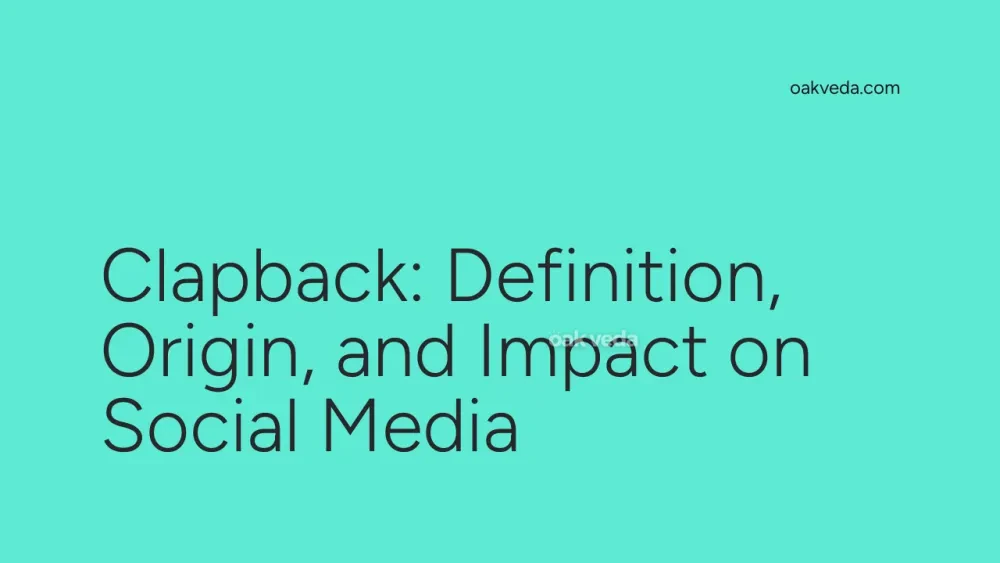
What is a Clapback?
A clapback is a sharp, witty, and often sassy response to criticism or negative comments on social media. It's a digital-age comeback that aims to shut down or challenge the original criticism with cleverness and assertiveness. Clapbacks have become a significant part of online discourse, particularly on platforms like Twitter, Instagram, and Facebook, where public figures, brands, and everyday users engage in rapid-fire exchanges.
Origin and Development of Clapback
The term "clapback" has its roots in African American Vernacular English (AAVE) and gained popularity in the early 2000s. While its exact origins are debated, many attribute the term's mainstream emergence to Ja Rule's 2003 song "Clap Back," a diss track aimed at rival rappers 50 Cent and Eminem. The song used the phrase to describe a forceful response to critics.
Since then, the term has evolved beyond its musical origins and become firmly entrenched in social media culture. The rise of Twitter, with its character limit encouraging concise, punchy responses, provided the perfect breeding ground for clapbacks to flourish.
How Clapbacks Work
A successful clapback typically has several key elements:
- Timeliness: It's usually a quick response to the original comment or criticism.
- Wit: The reply should be clever, often employing humor or sarcasm.
- Assertiveness: A good clapback confidently defends one's position or challenges the critic.
- Brevity: Clapbacks are often short and to the point, packing a punch in few words.
- Relevance: The response directly addresses the original comment or criticism.
On social media, clapbacks are often accompanied by the clapping hands emoji (👏) to emphasize each word or point, visually representing the "clapping back" action.
Popular Examples of Clapbacks
Celebrities and brands have mastered the art of the clapback, often gaining viral attention for their witty responses:
- Wendy's Twitter account: Known for its sassy replies to competitors and customers alike.
- Rihanna: The singer frequently delivers memorable clapbacks to critics and trolls.
- Chrissy Teigen: Her quick-witted responses to negative comments have become legendary on social media.
These high-profile clapbacks often garner thousands of likes, retweets, and media coverage, amplifying their impact.
Impact of Clapbacks on Social Media Culture
Clapbacks have significantly influenced online communication and social media culture:
- Engagement boost: Witty clapbacks can increase engagement rates and follower counts.
- Brand personality: For companies, well-executed clapbacks can humanize their brand and create a relatable online persona.
- Entertainment value: Clapbacks often provide entertainment for spectators, leading to increased virality.
- Empowerment: They can be a form of self-defense against online bullying or criticism.
However, the rise of clapback culture has also led to concerns about increasing hostility and confrontation in online spaces.
Controversies Surrounding Clapbacks
While clapbacks can be entertaining and empowering, they're not without controversy:
- Tone concerns: Some argue that clapbacks contribute to a more aggressive online environment.
- Misinterpretation: The intent behind a clapback can be misunderstood, potentially escalating conflicts.
- Overuse: Frequent clapbacks might be seen as attention-seeking or unprofessional, especially for brands or public figures.
- Cultural appropriation: As clapbacks originated in AAVE, there are discussions about their widespread adoption by non-Black individuals and brands.
How Brands and Influencers Use Clapbacks
Brands and influencers have embraced clapbacks as a marketing tool:
- Building brand voice: Clapbacks help establish a distinct, often humorous brand personality.
- Increasing engagement: Witty responses can boost social media metrics and brand awareness.
- Handling criticism: Some use clapbacks to address negative feedback or misconceptions publicly.
- Creating viral moments: A well-timed clapback can generate significant media attention and shares.
However, brands must tread carefully, as an ill-conceived clapback can backfire and damage their reputation.
Future Trends Related to Clapbacks
As social media continues to evolve, so too will the nature of clapbacks:
- Platform-specific clapbacks: Different social media platforms may develop unique clapback styles.
- AI-generated clapbacks: As AI language models advance, we might see automated clapback suggestions or responses.
- Visual clapbacks: With the rise of short-form video content, clapbacks may increasingly take video form on platforms like TikTok.
- Clapback fatigue: There may be a shift towards more constructive online discourse as users tire of confrontational exchanges.
FAQs about Clapbacks
-
Are clapbacks always negative? No, while often used in response to criticism, clapbacks can also be playful or used in friendly banter.
-
Can clapbacks be harmful? Yes, if used excessively or aggressively, clapbacks can contribute to a toxic online environment.
-
How can I craft a good clapback? Focus on wit, relevance, and brevity. Avoid personal attacks and aim for cleverness over cruelty.
-
Should brands use clapbacks? Brands should use clapbacks judiciously, ensuring they align with their overall social media strategy and brand voice.
In conclusion, clapbacks have become a significant aspect of social media interaction, reflecting the quick-witted, often confrontational nature of online discourse. While they can be entertaining and empowering, it's important to use them responsibly and consider their potential impact on the broader online community.
You may be interested in:
- TikTok Conversations: Definition, Origin, and Impact
- Not Me (??): Definition, Origin, and Impact on Social Media
- Unwell: Definition, Origin, and Impact on Social Media
- GIF: Definition, Origin, and Impact on Social Media
- Influencer Marketing: Definition, Origin, and Impact
- Nepo Baby: Definition, Origin, and Impact on Social Media

